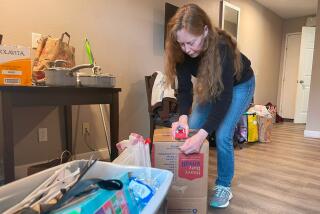Jewelry maker must retool after bout with cancer

Susan Braig is our Money Makeover for January. The 64-year-old cancer survivor has very limited income and savings but still finds she has enough money for Obamacare.
First, the cancer threatened Susan Braig’s life, then it wrecked her finances.
Now healthy at 64, Braig is worried about her future. Her primary income is the roughly $2,300 a month she gets from Social Security. Then there’s her home-based business, which brings in an average of $750 a month from jewelry making and grant writing. Her savings total less than $29,000.
“I’m one of those baby boomers who is now getting ready to face the next phase,” Braig said. “I look at it and I just want to curl up in a fetal position.
“Baby boomers were going to live forever and be healthy and be fit and be strong — and we’re not.”
Braig, of Altadena, is suffering from financial battle fatigue, said financial planner Dave DeWolf. That’s the result of years of struggling to pay down debts related to her successful fight against breast cancer.
“The problem we have to solve for Susan is how to get her out of that fetal position,” said DeWolf, a partner and chief financial officer at Abacus Wealth Partners in Manhattan Beach. “She’s already doing a lot of the right things, but she needs a road map and reassurance.”
Braig’s ordeal began when she was diagnosed with Stage 1 breast cancer in 2004. There was enough of a worry that the cancer had begun to spread that her doctor took no chances.
After a lumpectomy, she underwent chemotherapy and radiation treatments, followed by five years of pills to keep the cancer cells from coming back.
“My health prognosis was always excellent,” Braig said, “but my financial prognosis was disastrous.”
Braig said that at the time she had basic health insurance that didn’t kick in until she had paid a yearly $1,000 deductible and $2,500 in co-pays. It also didn’t cover the cost of outpatient care. Gap insurance helped some, but that ran out.
To pay for her treatment, Braig drained a retirement account that once contained $40,000; her medical and credit card debts jumped to $40,000 as she paid for her care.
The cancer that challenged her became Braig’s rallying cry for better, more affordable healthcare.
In 2008, she twice testified before state legislative committees in Sacramento.
“I’ve paid over $6,000 a year out of pocket, accumulated $40,000 in credit card debt, on top of what I pay in premiums, yet my insurance pays nothing,” she told legislators.
She became a member of Health Care for America Now, lobbying Congress and protesting outside the U.S. Chamber of Commerce in 2009.
Ultimately, in 2010, she canceled the insurance.
“I didn’t lose my health insurance. I couldn’t afford it,” Braig said, noting that the problem wasn’t the size of the premium but the limited coverage. “Many, like myself, have had to drop their plans altogether.”
She turned her anger into inspiration for the artistic talent she had nurtured since earning degrees in visual arts at the University of Cincinnati and Cal State Fullerton.
Braig makes unique jewelry with base metals such as copper and brass and adds expired pills and tablets, then seals them in resin for safety. She calls her line Designer Drug Jewelry and she sells the necklaces, pendants, earrings and tiaras in an Etsy store for $15 to $100 apiece.
“I call what I’m doing ‘assemblage,’” Braig said. “I find things that are already made and mix and match, glue and layer and come up with a repurposed piece.”
Braig said her wants and needs are small; she splits her modest expenses with a roommate. But next month, her portion of the rent will rise about 42% to $925 for the 85-year-old Altadena home she shares.
“All I really want is a roof over my head, a warm place to live, enough money left over to maybe go out to a play or a movie from time to time,” she said.
One bit of good news is Social Security. Her monthly check jumped to slightly more than $2,200 in June from a little more than $900, following the death of her former husband; that survivor benefit increased again this month to about $2,300, swelling her annual Social Securing income to about $28,000 from about $11,000.
A second favorable development was the Affordable Care Act, which meant Braig would once again have health insurance as of Jan. 1.
Because she had no health insurance for three years, Braig didn’t undergo expensive tests to determine whether she remains cancer free.
“I’m in good health, as far as I know,” Braig said, “but I know I’ve been taking risks.”
Upon learning late last year that Braig was putting off tests needed to make sure she was still healthy, DeWolf first wanted her to seek out her healthcare options under Obamacare. He advised that she call Covered California, the state-run health insurance exchange.
“Your situation was made for the nightmare we all went through to get this kind of healthcare coverage,” DeWolf said, adding that it wasn’t worth the risk of waiting until her 65th birthday in June, when she can enroll in Medicare. “You definitely have enough room on your budget. I would definitely pick up the insurance.”
Braig took the advice before the sign-up deadline and considered 10 plans available through Covered California. She selected an Anthem Blue Cross Silver plan that will cost her $345 a month, after a federal premium subsidy, and should cover her cancer tests. She could have picked the less expensive Bronze plan, but it might not have covered her tests, Braig said.
In spite of her difficulties, Braig has some strong points in her favor, DeWolf told the artist.
DeWolf praised Braig’s scrupulous recordkeeping and self-restraint when it comes to spending.
With her business income and Social Security, Braig is, on average, coming out a little ahead each month.
She has paid down her debt so that only about $6,000 remains, and that is interest free. That was something she negotiated with a credit card company when she canceled her card.
She need only pay the minimum now, DeWolf said.
“You are not in a situation where you are out living beyond your means. You’re not doing anything stupid with your money,” DeWolf said. “It’s not like what I see all of the time with attorneys who are earning $400,000, $500,000 a year and they are also spending $400,000 to $500,000 a year.”
Braig explained that her self-restraint comes from “taking a vow of poverty when I decided to become an artist,” specializing for several years in macrame, both by selling pieces she had created and writing books on the subject. But she also said it came from growing up during the turbulent political times of the 1960s and 1970s, when she became averse to a lifestyle of conspicuous consumption.
One essential change: getting rid of an annuity that makes up her savings because it has high fees and “few financial gains,” DeWolf said. He suggested rolling it over into an IRA that has one-fifth of the fees and costs.
“I recommend one that starts out at about 45% in bonds and then slowly increases its holdings in bonds over time, to make the investment safer,” DeWolf said.
Any additional savings, DeWolf said, should utilize the same type of account, but should go into a brokerage or investment account. Regular savings accounts, he said, aren’t keeping up with inflation.
Another important factor for Braig’s future is continuing to make as much money as she can, both in grant writing and in jewelry sales.
“You are going to have to work until you are 68,” DeWolf said. “So if you can earn $9,000 a year until you are 68, you are going to be in good shape, but if you can earn that much until you are 70 it just gives you that much more cushion. This is very important.”
Otherwise she would be reliant solely on Social Security, which wouldn’t be enough to live comfortably off of in her later years.
Braig said she feels a palpable sense of relief, knowing she was already on the right path in some ways, and will be able to meet “such solid, practical and achievable goals.”
Even better, Braig’s new insurance allowed for a mammogram. The results, 10 years after diagnosis: No cancer found.
Twitter: @RonDWhite
::
Do you need a money makeover? Each month the Sunday Business section gives readers a chance to have their financial situations sized up by a professional advisor at no charge. To be considered, send an email to makeover@latimes .com. You also can send a letter to Makeover, Business Section, Los Angeles Times, 202 W. 1st St., Los Angeles, CA 90012. Include a brief description of your financial goals and a daytime phone number. Information you send us will be shared with others.
More to Read
Inside the business of entertainment
The Wide Shot brings you news, analysis and insights on everything from streaming wars to production — and what it all means for the future.
You may occasionally receive promotional content from the Los Angeles Times.











